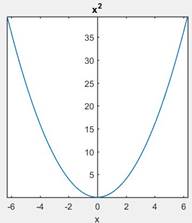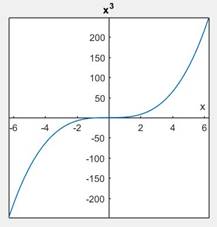
Concept explainers
a.
Explain what is even function.
a.
Answer to Problem 2RCC
The even function is a function which satisfy particular symmetry relation, w. r. t. taking additive inverse.

Explanation of Solution
Let f is a real-valued function of real variable. Then f is even if the following equation hold for all
We may rewrite the equation as,
Geographically, the graph of the even function is symmetric w. r. t. y-axis, meaning the graph remain unchanged after reflecting the y-axis.
For example, Let take a function
Then,
The function holds the symmetric relation so, it is even function.
Program:
clc clear close all syms x f=x^2; p=ezplot(f); p.LineWidth=1.25; ax=gca; set(ax,'linewidth',1.2,'fontsize',12); ax.XAxisLocation='origin'; ax.YAxisLocation='origin'; axis tight axis square
Query:
- Fist, we have defined the function.
- Then sketch a graph using “ezplot”.
b.
Show which trigonometric functions are even.
b.
Answer to Problem 2RCC
The trigonometric functions which are even is,
Explanation of Solution
Calculation:
Let’s take a function,
As we know that the even function follows the symmetry,
Then,
Similarly, for the
Then,
Conclusion:
The trigonometric function which are even is,
c.
Explain what is odd function.
c.
Answer to Problem 2RCC
The odd function is a function which satisfy particular symmetry relation, w. r. t. taking additive inverse.

Explanation of Solution
Let f is a real-valued function of real variable. Then f is odd if the following equation hold for all
We may rewrite the equation as,
Geographically, the graph of the odd function has rotational symmetric w. r. t. the origin, meaning the graph remain unchanged after rotating 180o about the origin.
For example, Let take a function
Then,
The function holds the symmetric relation so, it is odd function.
Program:
clc clear close all syms x f=x^3; p=ezplot(f); p.LineWidth=1.25; ax=gca; set(ax,'linewidth',1.2,'fontsize',12); ax.XAxisLocation='origin'; ax.YAxisLocation='origin'; axis tight axis square
Query:
- Fist, we have defined the function.
- Then sketch a graph using “ezplot”.
d.
Show which trigonometric functions are odd.
d.
Answer to Problem 2RCC
The trigonometric functions which are even is,
Explanation of Solution
Calculation:
Let’s take a function,
As we know that the even function follows the symmetry,
Then,
Similarly, for the
Then,
Conclusion:
The trigonometric function which are even is,
Chapter 5 Solutions
Precalculus: Mathematics for Calculus - 6th Edition
- uestion 10 of 12 A Your answer is incorrect. L 0/1 E This problem concerns hybrid cars such as the Toyota Prius that are powered by a gas-engine, electric-motor combination, but can also function in Electric-Vehicle (EV) only mode. The figure below shows the velocity, v, of a 2010 Prius Plug-in Hybrid Prototype operating in normal hybrid mode and EV-only mode, respectively, while accelerating from a stoplight. 1 80 (mph) Normal hybrid- 40 EV-only t (sec) 5 15 25 Assume two identical cars, one running in normal hybrid mode and one running in EV-only mode, accelerate together in a straight path from a stoplight. Approximately how far apart are the cars after 15 seconds? Round your answer to the nearest integer. The cars are 1 feet apart after 15 seconds. Q Search M 34 mlp CHarrow_forwardFind the volume of the region under the surface z = xy² and above the area bounded by x = y² and x-2y= 8. Round your answer to four decimal places.arrow_forwardУ Suppose that f(x, y) = · at which {(x, y) | 0≤ x ≤ 2,-x≤ y ≤√x}. 1+x D Q Then the double integral of f(x, y) over D is || | f(x, y)dxdy = | Round your answer to four decimal places.arrow_forward
- D The region D above can be describe in two ways. 1. If we visualize the region having "top" and "bottom" boundaries, express each as functions of and provide the interval of x-values that covers the entire region. "top" boundary 92(x) = | "bottom" boundary 91(x) = interval of values that covers the region = 2. If we visualize the region having "right" and "left" boundaries, express each as functions of y and provide the interval of y-values that covers the entire region. "right" boundary f2(y) = | "left" boundary fi(y) =| interval of y values that covers the region =arrow_forwardFind the volume of the region under the surface z = corners (0,0,0), (2,0,0) and (0,5, 0). Round your answer to one decimal place. 5x5 and above the triangle in the xy-plane witharrow_forwardGiven y = 4x and y = x² +3, describe the region for Type I and Type II. Type I 8. y + 2 -24 -1 1 2 2.5 X Type II N 1.5- x 1- 0.5 -0.5 -1 1 m y -2> 3 10arrow_forward
- Given D = {(x, y) | O≤x≤2, ½ ≤y≤1 } and f(x, y) = xy then evaluate f(x, y)d using the Type II technique. 1.2 1.0 0.8 y 0.6 0.4 0.2 0- -0.2 0 0.5 1 1.5 2 X X This plot is an example of the function over region D. The region identified in your problem will be slightly different. y upper integration limit Integral Valuearrow_forwardThis way the ratio test was done in this conflicts what I learned which makes it difficult for me to follow. I was taught with the limit as n approaches infinity for (an+1)/(an) = L I need to find the interval of convergence for the series tan-1(x2). (The question has a table of Maclaurin series which I followed as well) https://www.bartleby.com/solution-answer/chapter-92-problem-7e-advanced-placement-calculus-graphical-numerical-algebraic-sixth-edition-high-school-binding-copyright-2020-6th-edition/9781418300203/2c1feea0-c562-4cd3-82af-bef147eadaf9arrow_forwardSuppose that f(x, y) = y√√r³ +1 on the domain D = {(x, y) | 0 ≤y≤x≤ 1}. D Then the double integral of f(x, y) over D is [ ], f(x, y)dzdy =[ Round your answer to four decimal places.arrow_forward
 Calculus: Early TranscendentalsCalculusISBN:9781285741550Author:James StewartPublisher:Cengage Learning
Calculus: Early TranscendentalsCalculusISBN:9781285741550Author:James StewartPublisher:Cengage Learning Thomas' Calculus (14th Edition)CalculusISBN:9780134438986Author:Joel R. Hass, Christopher E. Heil, Maurice D. WeirPublisher:PEARSON
Thomas' Calculus (14th Edition)CalculusISBN:9780134438986Author:Joel R. Hass, Christopher E. Heil, Maurice D. WeirPublisher:PEARSON Calculus: Early Transcendentals (3rd Edition)CalculusISBN:9780134763644Author:William L. Briggs, Lyle Cochran, Bernard Gillett, Eric SchulzPublisher:PEARSON
Calculus: Early Transcendentals (3rd Edition)CalculusISBN:9780134763644Author:William L. Briggs, Lyle Cochran, Bernard Gillett, Eric SchulzPublisher:PEARSON Calculus: Early TranscendentalsCalculusISBN:9781319050740Author:Jon Rogawski, Colin Adams, Robert FranzosaPublisher:W. H. Freeman
Calculus: Early TranscendentalsCalculusISBN:9781319050740Author:Jon Rogawski, Colin Adams, Robert FranzosaPublisher:W. H. Freeman
 Calculus: Early Transcendental FunctionsCalculusISBN:9781337552516Author:Ron Larson, Bruce H. EdwardsPublisher:Cengage Learning
Calculus: Early Transcendental FunctionsCalculusISBN:9781337552516Author:Ron Larson, Bruce H. EdwardsPublisher:Cengage Learning





